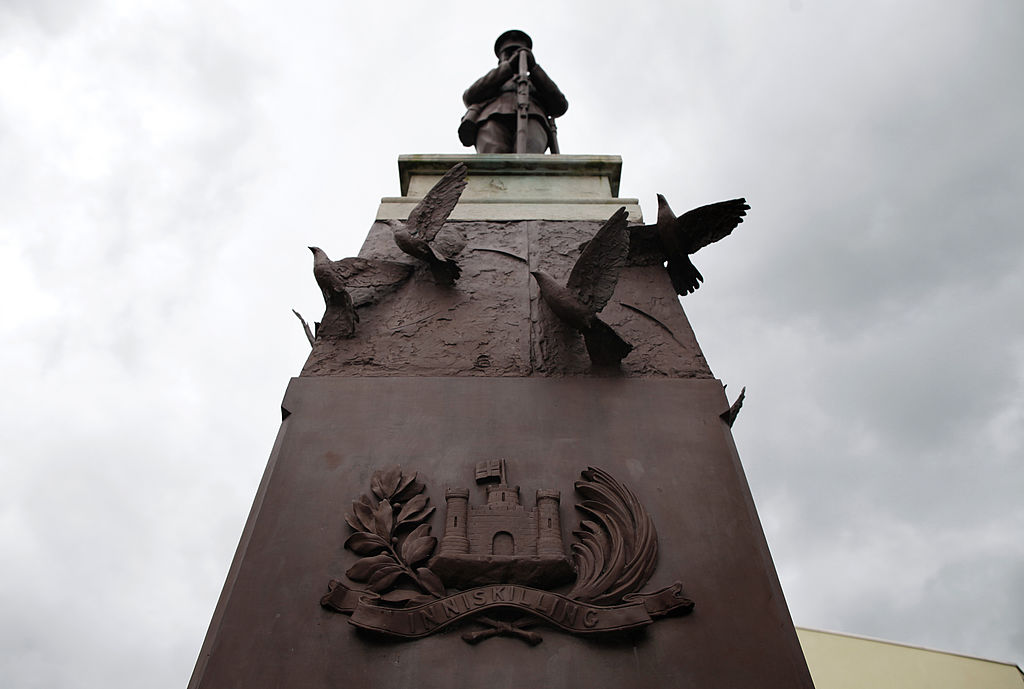In Northern Ireland, the dead are being eradicated. This week marks the 35th anniversary of the IRA bombing of a remembrance service in my hometown Enniskillen. In an attack so barbarous it was condemned at the time by the Kremlin, a bomb planted the night before slaughtered 12 of my neighbours standing around the town’s cenotaph. No warning had been given. The chemist, the teacher, the nurses, the retired police officer, the housewives, the house painter, all standing around a war memorial with the names of Catholic and Protestant locals on it who fought and died in the trenches, were cut to pieces. My father, one of the first responders, discovered his colleague and wife dead in the rubble. It was an image that haunted him to his death.
Thirty five years later Mary Lou McDonald, the leader of Sinn Fein, declared at her party’s annual conference that there was ‘no comparison’ between the IRA, inextricably linked to her party, and the gangland violence currently plaguing the Republic of Ireland. A Sinn Fein activist on the podium before her said of the IRA, ‘we have the right to remember, commemorate, recount the deeds of and yes, sing about our heroes.’ In the same week, a republican supporter and one time Sinn Fein candidate, Chris Donnelly opined on Twitter,
‘The further we move away from all our pasts, the less opinions on it matter to an increasing number in our society. Time will do that. Some are more at ease with that than others. Many will let resentment at an inability to control contested narratives consume them.’
It is difficult to reconcile the two statements. On the one hand, Sinn Fein reserves the right to glorify perpetrators who in any other context would be waiting their turn for a war crimes tribunal. On the other hand there seems to be an implication that inconvenient victims who refuse to forget are yesterday’s people whose unresolved grief and anger is illegitimate.
There wasn’t much of a contested narrative at Enniskillen on that day of infamy in November 1987 and certainly little to sing about. Here is one grievously wounded victim, Jim Dixon recounting his injuries:
‘My mouth was blown out. My jaw was missing on the right hand side. I was split open nine inches from my chin to my ear. My face and tongue were paralysed. I had nine broken ribs. My pelvis, two hips and one leg were smashed.’
Another largely forgotten and hideous postscript to the Enniskillen attack was that a further bomb was planted by the same IRA team in the tiny border village of Tullyhommon. It was timed to explode at a remembrance parade that almost entirely consisted of children in the Boys’ and Girls’ brigade. If that bomb, four times the size of the device in Enniskillen, had gone off as intended it would have created a massacre to rival anything in Bucha, Mariupol or Srebrenica.
This is the visceral reality of violent extremism that Sinn Fein would perhaps prefer us all to forget about and move on. But the thousands of families bereaved by the IRA are the ghosts at Sinn Fein’s ‘new Ireland’ banquet. They are also largely ignored by Northern Ireland’s extraordinary coalition of publicly funded human rights defenders, who attack the state for its conduct during the Troubles but remain mute on the terrorists who put so many more into the ground before their time.
There is a brutal logic in turning atrocities like Enniskillen into a squalid ‘regrettable but necessary’ event. Moving the public debate further away from the grotesque consequences of paramilitary violence means that the IRA’s living witnesses to their inhumanity will die off, after many suffer from years of physical and psychological torment without ever having anyone held to account for their suffering.
I often wonder about the terrorists who carried out the Enniskillen bombing. I wonder whether they are still alive, and if or how they reconcile the horror they caused with any sane image of a united Ireland. The bombers alive will surely be in late middle age or older by now, with the shadow of mortality growing shorter in front of them. I’ve met repentant terrorists across the ideological spectrum who were haunted to an early grave by the futility of their crimes.
But then the political descendants of one of western Europe’s most ruthless terrorist organisations are nothing if not resilient.
Imagine the mental toughness required from Sinn Fein’s leader, Mary Lou McDonald, to insist as she did that the IRA’s violent campaign was ‘justified.’ Imagine the psychological integrity required for Michelle O’Neill, Sinn Fein’s First Minister designate, to say there was ‘no alternative’ to their armed campaign, which resulted in attacks like the mass murder of men, women and children gathered around a war memorial. Now imagine any reconciled future in a unified Ireland between Unionists and Republicans with either of these people in charge.
No matter how much ‘justification’ is used, both Sinn Fein and the victims they wish to erase are chained by the same history. For Sinn Fein it is a reflexive, sullen defiance of morality that sees some compelled to lionise terrorists, many of whom would in other circumstances merely be ordinary psychopaths or serial killers. For the victims still alive, like the 63 people maimed in the rubble of Enniskillen, it is that refusal to condemn the IRA’s campaign as a futile, sectarian fantasy or even to give up the names of the perpetrators that holds them in their pain. Killing their dead over again.
For all the talk of a united Ireland, one that is worth living in cannot be built on forgetting. The organisations involved in this endeavour, the human rights academics and journalists busily making its case, are far more interested in building a utopia. The dead and bereaved of Enniskillen and countless other IRA atrocities know the truth though – those who forget the past are condemned to repeat it.







Comments